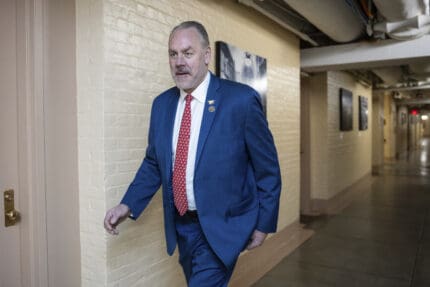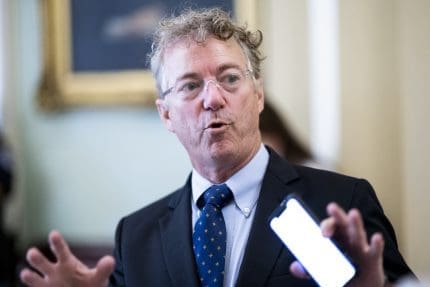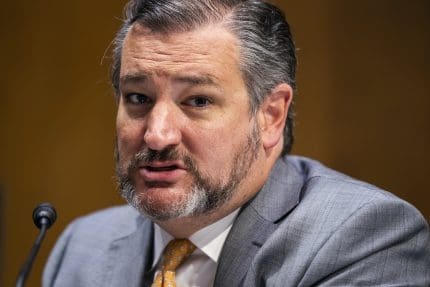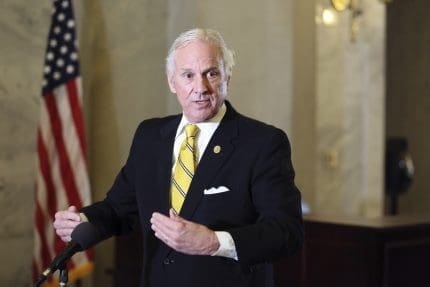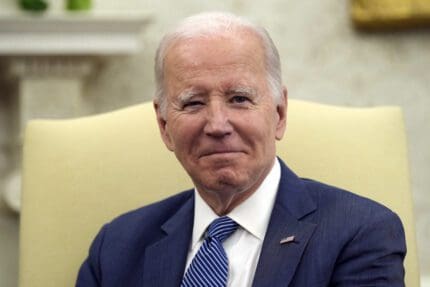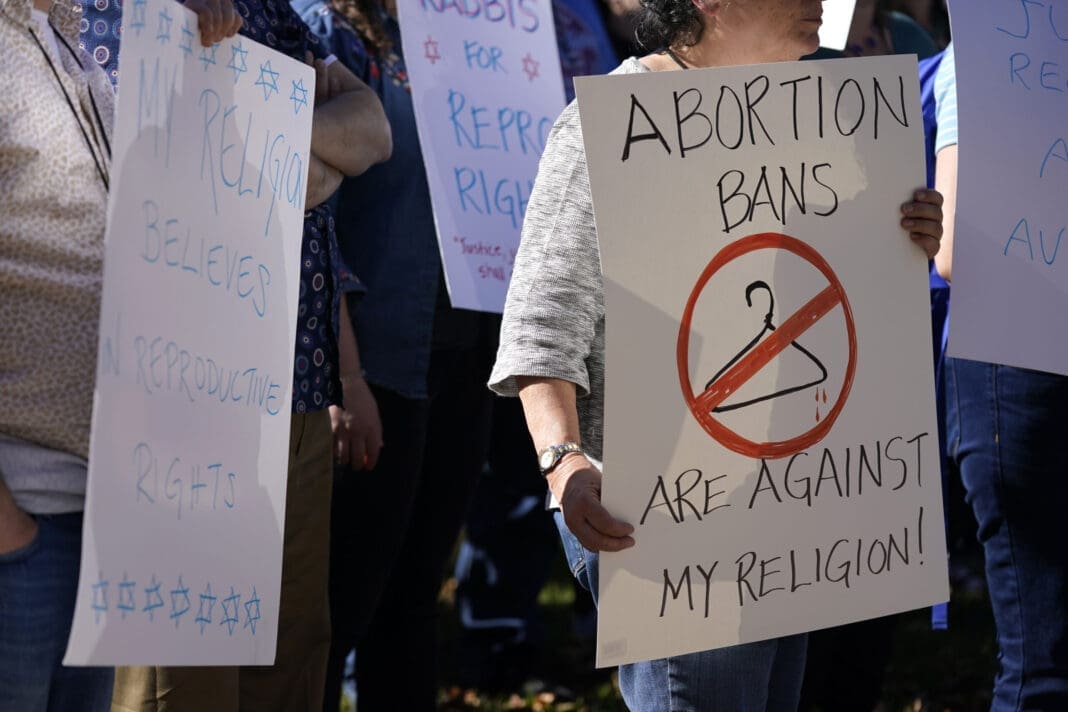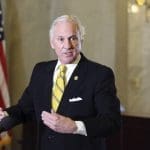Hikers fight against Trump border wall plan that could destroy monument
Engraved in the monument is this warning: ‘The destruction or displacement of this monument is a misdemeanor punishable by the United States or Mexico.’ Now the government is proposing to commit such a misdemeanor.
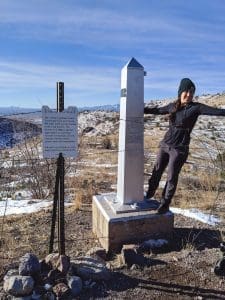
Tess Mullaney remembers looking at endless rolling desert hills covered in a thin layer of white snow just as the sun was rising the day she embarked on a 2½-month journey on the Arizona Trail, an 800-mile system that starts at the U.S.-Mexico border in Arizona and ends at the Arizona border with Utah.
In a picture from that day in February 2019, Mullaney, 28, is smiling as she poses behind the thin barbed-wire fence that divides Arizona from Mexico. She’s standing next to Border Monument 102, an engraved pillar marking the boundary of the United States.
Engraved in the monument is this warning: “The destruction or displacement of this monument is a misdemeanor punishable by the United States or Mexico.”
Now the government is proposing to commit such a misdemeanor. It plans to build a 30-foot border wall there, threatening the view so many hikers marvel at — and the ecological life around it.
Mullaney and others are calling on the government to abandon plans to build two miles of new fencing they say will destroy the monument that marks the beginning of the Arizona Trail, which is also within the Coronado National Memorial. That southern terminus marks where some believe Spanish explorer Francisco Vázquez de Coronado first crossed into Arizona from Sonora in the mid-1500s in his quest to find gold.
The government also plans to build a ground detection system, a road, and new lighting. It is all part of Donald Trump’s plan to build hundreds of miles of border wall, a campaign promise he has so far kept.
“To remove not only this symbolism, but also the beauty, seclusion, protection, and wildlife migratory abilities in this area would be saddening to all who enjoy it,” Mullaney said.
Known as “thru-hikers,” an estimated 700 people traverse the entirety of the Arizona Trail in one trip, and thousands more hike different parts of the trail, each year. Thru-hikers have to first be dropped off at a trailhead two miles from the border. They then hike down to the monument that marks where the trail starts, a crucial marker for adventurers, said Matthew J. Nelson, executive director of the Arizona Trail Association.
For years, that part of the border has been protected by a small barbed-wire fence, and Nelson said he doesn’t know of any issues with illegal border crossings there. The area is mountainous and rugged, difficult to access from the south.
Nelson said his opposition to the border wall project at that location isn’t political, but is about preserving the crucial point of a massive trail that took volunteers years to complete. He says the trail attracts thousands of visitors who stimulate the local economies of nearby communities, such as the city of Sierra Vista.
“It’s a point of pride, and so I hope that people recognize that impact to a quarter-mile of the trail is an impact to the entire 800-mile organism,” Nelson said.
U.S. Customs and Border Protection didn’t immediately answer questions about the project at the trail. During a press briefing in Tucson on Tuesday, acting Secretary of the Department of Homeland Security Chad Wolf said that the administration’s top goal is border security and that officials routinely meet with concerned stakeholders. Wolf was addressing a question about concerns that environmental groups have expressed about construction on federally protected land.
“But at the end of the day, I think the administration has been very clear on this front, which is border security is national security is homeland security. So we’re gonna secure that border every way we can,” Wolf said.
Wolf said decisions about where to build border barriers and where to rely more on technology for surveillance depend on factors such as illegal traffic in the area and how accessible it is.
“Those decisions are not being made by the secretary. They’re being made by the operators on the ground. So I think the best thing this administration has done is we’ve actually listened to the operators,” Wolf said.
The proposed project in the Coronado National Memorial is one of several planned for Arizona, which shares about 370 miles of border with Mexico.
Although the spot is federally protected by the National Trail System Act, the government has the power to override such a designation in the name of national security. It has already done that in places such as Organ Pipe Cactus National Monument, where construction workers have removed hundreds of protected cactuses and blasted through a mountain to build a new wall.
Greg Kilroy, a 50-year-old residential real estate agent, remembers first approaching the trail’s southern terminus — Border Monument 102 — in August, when most of Arizona is scorching, but when mountainous areas at high altitudes are nice and cool.
“It’s really epic,” Kilroy said. “It was also the beginning of our trip, and so it was really exciting, really kind of magical, and, not gonna lie, a little bit of fear and anxiety of what are we taking on here as part of the really long journey.”
It took Kilroy and his friend four years and about 17 different trips to complete the 800-mile trail. He said they found discarded trash they think was probably left behind by border crossers, but never encountered another person there.
“It was a true kind of wilderness experience. And boy, the wall would sure fly in the face of that,” Kilroy said.
Recommended

President Biden visits Prince William park to talk solar, youth involvement on Earth Day
Virginia set to receive $156 million from U.S. Environmental Protection Agency program
By Charlie Paullin, Virginia Mercury - April 23, 2024
Texas governor and attorney general do little to curb state’s chemical plant crisis
Republicans Greg Abbott and Ken Paxton have taken thousands of dollars in donations from chemical companies and their affiliated PACs.
By Jesse Valentine - December 08, 2023
‘We’ve been waiting for this’: Union workers cheer Biden’s hydrogen hub plan
Federal funding for the hub is estimated to bring over 20,000 jobs to the Pennsylvania-New Jersey-Delaware area.
By Anna Gustafson - October 17, 2023


















